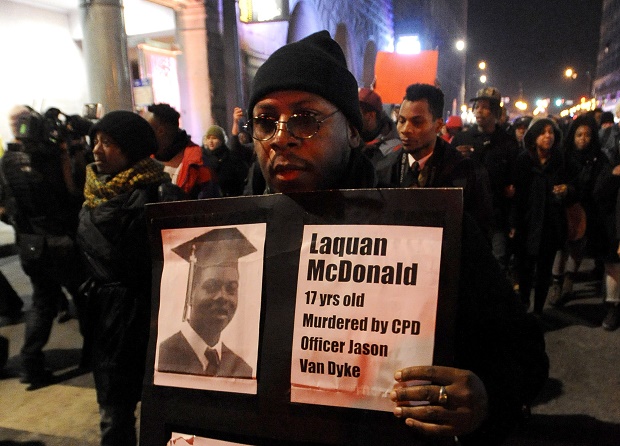Teen killed by Chicago officer had broken, troubled family

In this Tuesday, Nov. 24, 2015, file photo, a protester holds a sign as people rally for 17-year-old Laquan McDonald, who was shot 16 times by Chicago Police Department Officer Jason Van Dyke in Chicago. McDonald, whose name demonstrators are shouting as they march the streets and plan to shut down the city’s glitziest shopping corridor on Friday, lived a troubled life full of disadvantages and at least one previous brush with the law. AP FILE PHOTO
CHICAGO — A black teenager shot 16 times by a white Chicago police officer was a ward of the state when he died, having spent years being shuttled between different relatives’ homes and foster care from the time he was 3.
Laquan McDonald, whose name demonstrators have shouted for two days and will shout again during a planned rally to disrupt the city’s famed Magnificent Mile shopping corridor Friday, lived a troubled, disadvantaged life and had at least one previous brush with the law.
School officials and the McDonald family lawyer say there were signs Laquan was trying to get his life in order, though prosecutors say he had drugs in his system and was burglarizing cars on Oct. 20, 2014 — the night a squad-car video captured officer Jason Van Dyke shooting him.
“It takes a while to get a life back on track,” said Thomas Gattuso, the principal at the alternative high school that McDonald was attending. “With Laquan, we unfortunately never got to finish his story.”
Protesters and civil rights activists are demanding more investigations and police reform after Van Dyke was charged with first-degree murder this week. There have been two nights of small, peaceful demonstrations, and the Rev. Jesse Jackson and others have called for a “massive” march on Black Friday along Michigan Avenue. The swank downtown boulevard is normally packed on Black Friday, which is the day after the Thanksgiving holiday and one of the busiest shopping days of the year as US retailers offer discounts.
Article continues after this advertisementREAD: Protesters decry shooting death of black teen in Chicago
Article continues after this advertisementMcDonald’s family has appealed for calm, and his mother at least initially opposed the public release of the graphic dashcam video showing his death, attorney Michael Robbins said.
“Don’t resort to violence in Laquan’s name,” a family statement said Monday.
The family, who received a $5 million settlement from the city months before Van Dyke was charged even without filing a lawsuit, has declined to speak with the media. Robbins would not comment on the family’s history other than acknowledging it was broken up. He said McDonald grew up without his father involved in his life.
McDonald’s mother had been making efforts to regain custody of her son before he was killed and had been granted permission to take a younger sister back into her home, Robbins said.
“The mother was pursuing a petition to reunite the family,” he added.
McDonald spent most of his 17 years as a ward of the state. According to Illinois Department of Children and Family Services’ records, he was taken from his mother at age 3 in 2000 because the agency had deemed that his mother didn’t provide him with proper supervision. He was placed in a foster home.
He later moved to his great-grandmother’s, and returned to his mother in 2002. But citing physical abuse by the mother’s then-boyfriend, the state again took McDonald away. From around age six to 16, he lived with his great-grandmother and then stayed in the same house with an uncle after his great-grandmother died in 2014.
McDonald was arrested for possession of marijuana in January 2014, DCFS records indicate. Following his arrest, he was in juvenile detention until May 2014.
On the night he was shot, police suspected him of breaking into vehicles and stealing radios, Cook County State’s Attorney Anita Alvarez said. As police approached him, he allegedly slashed a tire of one of the squad cars with a knife. An autopsy report later said small amounts of PCP, a hallucinogenic drug, were found in the teen’s system.
READ: Chicago cop charged with murder in teen’s death; video released
Gattuso said McDonald took the initiative to attend Sullivan House High School, a school for at-risk students and high school dropouts between the ages of 16 and 21. That was some proof McDonald understood he needed to get his life together, Gattuso said, describing McDonald as quick to smile and hug his teachers. He regularly made As and Bs, Gattuso said.
“Nothing (bad) came up with him,” Gattuso said. “He never got into any trouble here.”
At the news conference announcing the release of the video, Chicago Police Superintendent Garry McCarthy acknowledged the difficulties in McDonald’s life — and his death.
“In this case, we have a tragic ending unfortunately to a tragic life of a young man who was betrayed on a number of different levels,” he said. “And typically, these cases end up in the police department’s hands. And, in this case, it ended up in his death.”